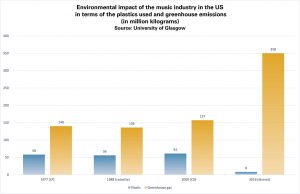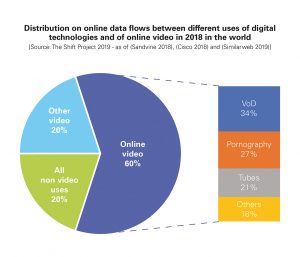Sober digital practices
Isabelle Métrope, ICB managing editor
Sober digital practices: a new notion that invites us to act responsibly when consuming digital products. The amount of information available has grown exponentially in the last decades (as an example, more than 500 hours of content are uploaded to YouTube every minute[1]). So far, our consumption shows no sign of decreasing. ICB gathered a couple of statistics to help us consider the place music takes in this whole situation.
Let’s start with a definition:
Information and communication technologies (ICT): Diverse set of technological tools and resources used to transmit, store, create, share or exchange information. These technological tools and resources include computers, the Internet (websites, blogs and emails), live broadcasting technologies (radio, television and webcasting), recorded broadcasting technologies (podcasting, audio and video players and storage devices) and telephony (fixed or mobile, satellite, visio/video-conferencing, etc.). [2]
With the increasing and the broadening of the information and communication technologies, including the acceleration of the digitisation of music, the amount of palpable material used in the music industry has seemingly dropped. Our first thought is that this development might be respectful of our environment: less plastic production ergo less trash, and our music storage (being only some space on any kind of device) is basically eternal. Of course, it costs energy to store and access, but compared to the energy saved by not shipping millions of CDs across the planet, and by not having to recycle obsolete media, it’s probably much less severe than really big producers of greenhouse gas emissions such as factories, planes and cars… isn’t it? Well.
Digital technologies now emit 4% of greenhouse gas emissions (GHG), that is to say more than civil aviation. This share could double from now to 2025 to reach 8% of all GHG emissions, i.e. the current share of car emissions. (2019, source: TheShiftProject.org)
Oops. And to put this number on a timeline: back in 2013, ICT’s share was only 2.5%. A vertiginous expansion, which doesn’t yet include the just as vertiginous shift in the use of online communication caused in 2020 by the pandemic. This shift resulted in a skyrocketing number of remote workers in need of online conference solutions, in a general demand for even more cloud-shared space and – very, very small indeed in comparison – in an increased number of produced and shared choir videos, online rehearsal solutions and online festivals. This being said, one big difference between the choir world and the “rest of the world” is that as music really lives from being shared together in one (non-virtual) room, and it is most likely that the majority of the choir data exchanged online because of the COVID crisis will return offline as soon as possible. Though: is digitised music greener?
The Universities of Glasgow, Scotland, and Oslo, Norway, conducted a common research project comparing the greenhouse gas emissions and the plastic productions of various music media over the last decades. This comparison is based on US statistics, but the trend depicted here could likely be broadened. The years used are the peak years of the corresponding media according to the Recording Industry Association of America.
To cut a long story short: the amount of plastic used in the US music industry dropped from 58 million kilograms in 1977 to 8 million kilograms in 2016. Meanwhile, the greenhouse gas emissions burst to reach 350 million kilograms for the year 2016 alone.
In the amount of greenhouse gas produced, the research includes streaming as well as any kind of download.
Choirs recording CDs often don’t have much choice: the vast majority of labels display the work of their artists online on the usual streaming platforms, and abstaining from digitisation would mean renouncing opportunities. It would be interesting though to reflect on how often we as consumers stream music which we actually already own on a local data storage medium, being a CD or a hard disk. Habits sneak in fast…
Music-David against Video-Goliath
The Shift Project is a French think tank “dedicated to informing and influencing the debate on energy transition in Europe”. As a matter of fact, this website is a useful source of interesting content for whoever would like to shift to a so-called “post-carbon economy”.
Among the available research results, one number is mind-blowing. When ICT, as stated above, is responsible for 4% of greenhouse gas emissions, these very emissions are dominated by one particular form of digital use:
Video flows represented 80% of global data flows in 2018 (…). These other non-video data flows cover extremely varied uses: web sites, emails, instant messaging, the storage of photos and various data, company networks, etc.
(source: TheShiftProject.org)
Online video viewing, which makes up the major part, generates more greenhouse gas than Spain in one whole year[3].
Talking about streaming: according to the IFPI Global Music Report 2021, “total streaming (including both paid subscription and advertising-supported) grew 19.9% and reached $13.4 billion, or 62.1% of total global recorded music revenues”. In the same period, the revenues of physical formats (CD, LP, etc.) lost 4.7%: reaching, with $4.2 billion, approximately 19.5% of the global recorded music industry revenues – 6 times less than 20 years ago.
Many a mickle makes a muckle
Flannery Ryan’s article offers food for thought and action for choirs and event organisers. Here are some ideas to shift on an individual level to a more responsible and sober digital practice:
- The aforementioned Shift Project has developed a CO2 calculator browser add-on called Carbonalyser[4], which depicts the amount of greenhouse gas emitted in a set period of time as well as, among others, the five visited websites that transferred the biggest amount of data.
- Most of the online videos are available in various qualities up to HD. Adapt the quality to the device you are using.
- Deactivate Autoplay on video platforms and decide yourself what you want to watch.
- Look at the high stack of books staring at you… how would it look if you reduced your online video consumption?
- Download your favourite music instead of streaming it on a regular basis.
- Looking for music on YouTube, but no need for the picture? Use add-ons like “YouTube Audio” to stream only the music.
- Spring-cleaning on your devices is not a fun activity, but you will feel lighter afterwards – and so will your energy consumption (and your device).
- Activate the dark mode of your apps or software. Your eyes will be relieved, as will the battery of your laptop or smartphone.
According to Carbonalyser, I produced 118g of CO2 when writing this article. This is indeed the emission produced by my extensive research of verified statistics. It would have been better for the environment if I had just made them up… but in the end, it’s all a matter of choice.
Links
- “Lean ICT: Towards digital sobriety”: Our new report on the environmental impact of ICT: https://theshiftproject.org/en/article/lean-ict-our-new-report/
- UNESCO Institute for Statistics: http://uis.unesco.org
- Our World in Data: https://ourworldindata.org is a project of the Global Change Data Lab in collaboration with the University of Oxford.
- IFPI Global Music Report 2021: https://www.ifpi.org
 Isabelle Métrope is a singer, conductor and the managing editor of the International Choral Bulletin. She studied applied languages and music management, as well as conducting, singing and pedagogy, which is the cause as well as the result of a compulsive curiosity naturally leading to a strong interest in systematic musicology. Apart from singing solo and in several professional choirs, her favourite activities include page setting, translating, baking cakes, taking pictures and travelling around the Mediterranean. Oh, and she loves statistics – surprisingly enough. Email:icb.editor@ifcm.net
Isabelle Métrope is a singer, conductor and the managing editor of the International Choral Bulletin. She studied applied languages and music management, as well as conducting, singing and pedagogy, which is the cause as well as the result of a compulsive curiosity naturally leading to a strong interest in systematic musicology. Apart from singing solo and in several professional choirs, her favourite activities include page setting, translating, baking cakes, taking pictures and travelling around the Mediterranean. Oh, and she loves statistics – surprisingly enough. Email:icb.editor@ifcm.net
Edited by Karen Bradberry, Australia
[1] Source: YouTube.com
[2] Source: UNESCO Institute for Statistics
[3] Source: University of Oxford project https://ourworldindata.org
[4] Look for it on www.ecosia.org, “the search engine that plants trees”!


